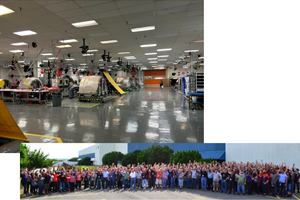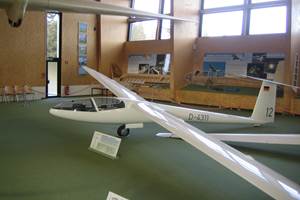Aerospace outlook: A dynamic, evolving supply chain and market
With major new aircraft programs on the horizon, the aerospace industry is looking to reduce costs and increase efficiencies.
The aircraft production market is set to grow 5.8% annually, from a value of US$164 billion in 2017 to US$218 billion in 2022, according to The Teal Group. The largest segment, air transport, will grow 6.5% annually and will exceed US$150 billion by 2022. The macro factors driving this prediction include a steady upward growth in the total number of global airline passengers, with a 7.6% growth in revenue passenger kilometers (RPKs), 6.3% growth in airline seat kilometers (ASKs, the number of available seats times the distance flown), 9% growth in freight ton kilometers (FTKs) and an overall passenger load factor of 81.4%. The Boeing 737 MAX and Airbus A320neo family will drive the growth in aircraft deliveries and revenue, and a big part of that growth will come from aeroengine production. Air transport engine manufacturing is currently worth $17 billion, and is led by the CFM56, made by CFM International (a 50/50 joint venture between Safran and GE), the Trent XWB by Rolls Royce and the GE90 from GE Aviation.
The industry is currently awaiting Boeing’s formal announcement of its proposed new mid-size airplane (NMA) to meet the needs of the “middle of the market (MoM)” space — an aircraft larger than the 737 or A319/320/321, but smaller than the 777, 787 or A330, intended to replace the now-retired 757 and 767. This MoM segment is difficult to build for, as it represents the intersection of narrow-body and wide-body (twin-aisle) designs, and decisions revolve around issues such as cargo volume, boarding time and gate turnaround time. The question of which engine supplier will be selected for the NMA — bids were reportedly submitted in June 2018 — is yet to be answered. Airbus could respond to the NMA with a stretch version of the A321, dubbed A322, equipped with larger engines and composite wings. According to Boeing, the NMA will prioritize cost reduction over new technology introduction, and low-cost materials and processes will likely be a priority. Although Boeing has indicated that the fuselage and wing will likely be composite, the company may tailor the materials to reduce costs.
The business jet and general aviation segment has been relatively flat since 2010, after an unusual spike in 2008, and there are signs that business jet deliveries are set for an increase. Large, very large and ultra large private jets will lead the way, with planes such as the Gulfstream G650ER. After years of flat spending, the US defense budget is on the rise with a FY2019 request of $686 billion. The F-35 will dominate US military fixed-wing deliveries, followed by Northrop Grumman’s B-21, which will be the second largest military jet program by 2026.
These market predictions reflect four significant factors that are currently influencing the aerospace supply chain: customer consolidation, increasing vertical integration, the disruptive growth of additive manufacturing, and the political climate, including protectionism and tariffs. Related to customer consolidation, a duo-duopoly has lately emerged, following Airbus’ purchase of a 50.1% stake in Bombardier’s CSeries program, now branded as the A220, and Boeing’s purchase of an 80% stake in Embraer. With these purchases, the Big Two will get even bigger and bring more pressure on suppliers. At the same time, aircraft equipment suppliers are also consolidating, including UTC and Collins (that deal is awaiting Chinese government approval) as well as Safran and Zodiac, a merger that occurred earlier in 2018.
An ongoing trend towards vertical integration is apparent at Boeing, where it seems the company will play a greater role as a systems integrator on future programs. In my view, this likely means direct relationships with more suppliers going forward than during the 787 experience. And, consistent with more vertical integration, Boeing is also exploring selective use of “focused factories” at the Tier 2 level — facilities with a narrow range of products, customers and processes for greater efficiency and simplicity. Boeing has already made vertical integration moves in avionics, interiors and auxiliary power units (APUs), including a recently announced APU joint venture plan with Safran. Airbus, in similar fashion, has decided to vertically integrate by offering nacelles for the Pratt & Whitney PW1100G-powered A320neo. While UTC Aerospace Systems (UTAS) is the current nacelle supplier for the PW1100G, Airbus plans to compete against it by the mid-2020s. Additional OEM targets for vertical integration are myriad and could include virtually any aircraft subsystem.
Additive manufacturing continues to gain ground in aerospace. Norsk Titanium is already producing four structural titanium parts for the 787, via rapid plasma deposition (RPD). Further, Norsk expects the US Federal Aviation Admin. (FAA) to eventually certify the manufacturing process and material properties so that they can be used on more 787 parts and for other aircraft. Norsk has separately announced an agreement with Spirit AeroSystems for more additive parts, as part of Spirit’s ongoing cost reduction efforts. RPD reportedly can cut the buy-to-fly ratio down to about 3:1 — much lower than traditional processes. Airbus has also introduced an additively manufactured titanium part for the A350, a bracket for a serial production A350 pylon produced by Arconic. Arconic (Alcoa Inc.’s new name) has several long-term agreements to 3D print titanium fuselage components and superalloy ducting for the A320 and A350. Airbus also has a research effort underway with US-based Sciaky Inc. to evaluate its electron beam additive manufacturing process.
In the Tier 1 space, GE continues to expand its additive manufacturing activities — it recently announced creation of a separate business to focus on third-party additive manufacturing. Its 2016 acquisitions of Arcam and Concept Laser are key enablers for technology adoption. For example, 35% of the parts on GE’s Catalyst turboprop (which powers the Cessna Denali aircraft) will be additively manufactured. It has been reported that 855 conventionally manufactured parts have been replaced by just 12 additive parts in the Catalyst engine, greatly reducing complexity and speeding production. The engine will enter service in 2019. And, in 2017, GE’s Auburn, AL, US, facility 3D printed more than 10,000 LEAP engine fuel nozzle injectors.
As for the political situation, the impact of tariffs and counter-reactions is a major wildcard. Earlier this year, the Trump Administration announced 25% tariffs on imported steel and a 10% levy on imported aluminum, both of which are key aerospace raw materials. The tariffs include mill product as well as forgings, castings, extrusions and pipe. Canada and Mexico were initially exempted from these tariffs, but in June 2018, tariffs were applied to them based on “national security concerns.” Unfortunately, the proposed revision to the NAFTA agreement does not remove the raw material tariffs on Canada and Mexico. The estimated impact of tariffs on aerospace mill product is US$100 million to $200 million; the impact on forgings, castings, extrusions and pipe is unknown at this point. Additional tariffs were imposed on China in several large tranches covering many industries. These tariff moves raise key questions: What is the end game for the Trump Administration? Will China target Boeing for retaliation? And which suppliers will absorb the costs? How the answers play out over the next few years will, it is hoped, keep the aerospace industry on a growth trajectory.
Related Content
Creating a culture of excellence in aerocomposites
ST Engineering MRAS discusses the importance of addressing human factors to reduce separator inclusion in bonded structures.
Read MoreFrom sailplanes to composites repair: Growing composite training opportunities over the years
Mike Hoke discovered his interest in the composites industry at a young age. His journey eventually led him to Abaris Training Resources, which he owned and evolved for more than 30 years.
Read MoreComposites opportunities in eVTOLs
As eVTOL OEMs seek to advance program certification, production scale-up and lightweighting, AAM’s penetration into the composites market is moving on an upward trajectory.
Read MoreAugmenting engineered thermoplastics with natural fibers
The Paris Climate Accord mandate for net-zero carbon by 2050 has kick-started an innovation revolution for natural fibers and sustainably engineered resins.
Read MoreRead Next
From the CW Archives: The tale of the thermoplastic cryotank
In 2006, guest columnist Bob Hartunian related the story of his efforts two decades prior, while at McDonnell Douglas, to develop a thermoplastic composite crytank for hydrogen storage. He learned a lot of lessons.
Read MoreComposites end markets: Energy (2024)
Composites are used widely in oil/gas, wind and other renewable energy applications. Despite market challenges, growth potential and innovation for composites continue.
Read MoreCW’s 2024 Top Shops survey offers new approach to benchmarking
Respondents that complete the survey by April 30, 2024, have the chance to be recognized as an honoree.
Read More


















.jpg;maxWidth=300;quality=90)










